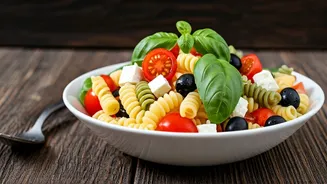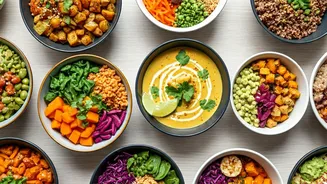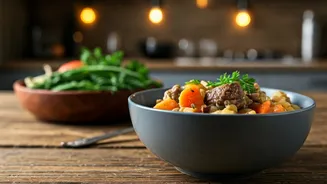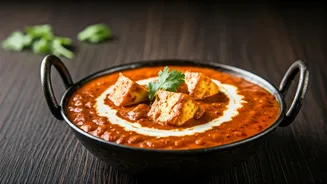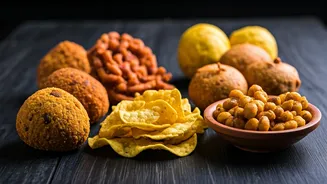Choosing the Pasta
Selecting the right pasta sets the stage for pasta salad success. The ideal choices are those that hold dressing well, like rotini, farfalle (bow-tie),
or penne. These shapes have crevices and curves where the dressing can cling, ensuring each bite is bursting with flavor. Avoid pasta that is too delicate, such as angel hair, or those that become overly soft when cooked. Cook the pasta al dente, meaning 'to the tooth.' It should have a slight firmness when bitten, preventing it from becoming mushy after it’s chilled and mixed with the dressing and other ingredients. Rinsing the cooked pasta under cold water stops the cooking process, and removes excess starch, keeping the salad from becoming sticky. This also helps to cool the pasta, which is essential for the flavors to meld together nicely. The type of pasta and how it is prepared directly impacts the final texture and enjoyment of the salad.
Flavorful Dressing Options
The dressing is what truly makes a pasta salad shine. A classic vinaigrette is a great foundation, typically made with olive oil, vinegar (like red wine or balsamic), Dijon mustard, and seasonings such as salt, pepper, and perhaps a pinch of sugar. These ingredients should be whisked thoroughly until emulsified, resulting in a creamy texture that beautifully coats the pasta. Another popular option is a creamy dressing, perhaps using mayonnaise or Greek yogurt as a base, blended with herbs, spices, and a touch of lemon juice. For a tangy twist, consider adding a splash of apple cider vinegar. When adding the dressing, start with a small amount, mixing well, and add more to taste. You can also incorporate ingredients directly into the dressing, like fresh herbs (basil, parsley, or dill) or roasted garlic for added depth of flavor. Remember to taste and adjust seasonings as needed.
Adding Fresh Vegetables
Vegetables introduce both color and texture to your pasta salad. Choose a variety to enhance the dish's appeal. Cherry tomatoes, halved or quartered, provide a burst of sweetness. Cucumber, diced, offers a refreshing crunch. Bell peppers (red, yellow, or orange) add a slightly sweet taste. Red onion, finely diced, gives a sharp bite (you can soak the red onion in cold water for a few minutes to lessen its harshness). Olives, whether black or green, provide a salty, briny counterpoint. When selecting vegetables, aim for freshness and consider seasonal availability for the best flavor. Preparing the vegetables is just as important. Chop or dice the vegetables into bite-sized pieces to ensure they mix well with the pasta and dressing. If using vegetables like broccoli or asparagus, consider blanching them briefly to soften them slightly and enhance their color. For tomatoes and cucumbers, removing excess moisture prevents the salad from becoming watery. Vegetables should be mixed with the pasta and dressing just before serving to maintain their texture and appearance.
Protein & Flavor Boosters
Elevate your pasta salad with added protein and complementary flavors. Grilled chicken or shrimp, cut into bite-sized pieces, are fantastic additions. Cooked and crumbled bacon lends a smoky, savory component. Cubes of cheese, such as mozzarella, feta, or cheddar, contribute creaminess and saltiness. Canned tuna or salmon, drained, can be a budget-friendly and delicious protein choice. For a vegetarian option, consider chickpeas or cannellini beans. When incorporating protein, think about how it complements the other ingredients. Grilled proteins often work well with vinaigrette-based dressings. Bacon adds a salty, crispy element that pairs well with various dressings and vegetables. Cheese can add a creamy texture that harmonizes with both vinaigrette and creamy dressings. Always make sure the protein is fully cooked. Allow protein components to chill before adding them to the pasta salad. This ensures that all components of the salad are at the same temperature when served.
Assembling Your Salad
The order in which you assemble the pasta salad can make a difference. First, combine the cooked, cooled pasta with the dressing. Ensure the pasta is well coated. Then, add the vegetables, stirring gently to avoid crushing them. Next, incorporate the protein and other additions like cheese or olives. Stir everything together, ensuring all ingredients are evenly distributed. It’s best to mix the salad at least a few hours before serving, or even the day before, to allow the flavors to meld. Cover the salad tightly and refrigerate. Right before serving, give the salad a final stir, taste it, and adjust seasonings as needed. If it seems a bit dry, add a touch more dressing. For a garnish, you can sprinkle fresh herbs, such as chopped parsley or basil, over the salad before serving. This not only adds visual appeal but also enhances the flavor profile. Ensure that you serve the pasta salad chilled, as it tastes best when the flavors are fully developed and the textures are at their peak.
Serving and Variations
Pasta salad's versatility makes it ideal for countless variations. Try different types of pasta, dressings, and ingredients to keep things exciting. For a Mediterranean twist, add feta cheese, Kalamata olives, sun-dried tomatoes, and a lemon-herb vinaigrette. A Southwestern-inspired salad could feature black beans, corn, avocado, and a spicy lime dressing. For a Caprese-style salad, use small pasta shapes, mozzarella balls, cherry tomatoes, fresh basil, and a balsamic glaze. For a quick and easy meal, consider adding leftover grilled chicken, pesto, and some parmesan cheese. Pasta salad can be served as a side dish at a barbecue, picnic, or potluck, or it can be a complete meal on its own. For a crowd, you can prepare a large batch of pasta salad, using a big bowl. Use serving spoons or tongs to offer the salad to the guests. The leftovers can be stored in an airtight container in the refrigerator for up to three days. Remember, the best pasta salad is one that you tailor to your own preferences and the season's best ingredients.
